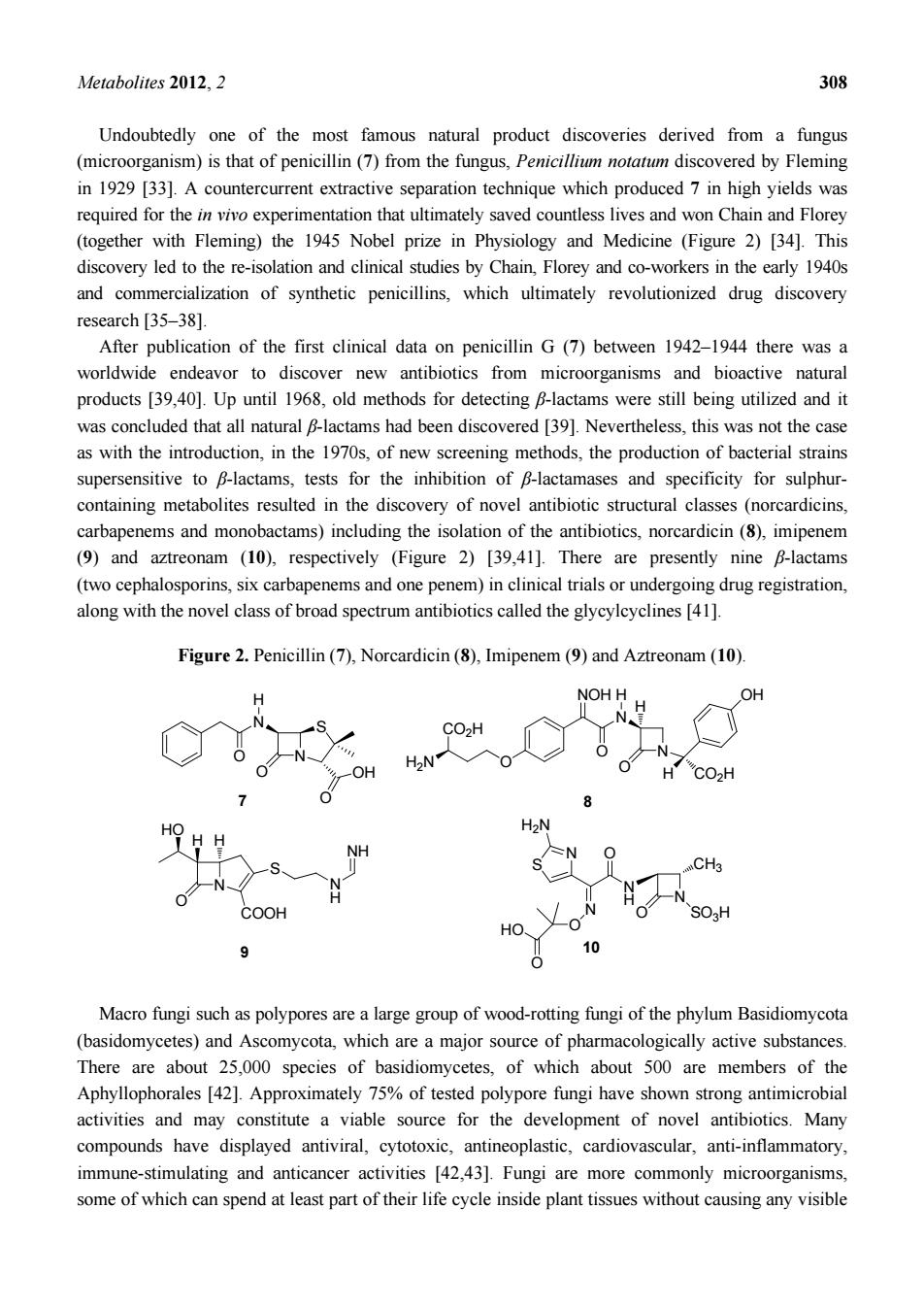正在加载图片...

Metabolites 2012.2 308 Undoubtedly one of the most famous natural product discoveries derived from a fungus (microorganism)is that of penicillin (7)from the fungus,Penicillim nom discovered by Fleming in 1929 [33].A countercurrent extractive separation technique which produced 7 in high yields was required for experimentation that ultimately saved countless lives and won Chain and Florey (together with Fleming)the 1945 Nobel prize in Physiology and Medicine (Figure 2)[34].This discovery led to the re-isolation and clinical studies by Chain,Florey and co-workers in the early 1940s and commercialization of synthetic penicillins,which ultimately revolutionized drug discovery research [35-38]. After publication of the first clinical data on penicillin G(7)between 1942-1944 there was a worldwide endeavor to discover new antibiotics from microorganisms and bioactive natural products [39,40].Up until 1968,old methods for detecting B-lactams were still being utilized and it was concluded that all natural B-lactams had been discovered [39].Nevertheless,this was not the case as with the introduction.in the 1970s.of new screening methods.the production of bacterial strains supersensitive to B-lactams,tests for the inhibition of B-lactamases and specificity for sulphur- containing metabolites resulted in the discovery of novel antibiotic structural classes (norcardicins carbapenems and monobactams)including the isolation of the antibiotics.norcardicin (8).imipenem (9)and aztreonam (10),respectively (Figure 2)[39,41].There are presently nine B-lactams (two cephalosporins,six carbapenems and one penem)in clinical trials or undergoing drug registration, along with the novel class of broad spectrum antibiotics called the glycylcyclines [41]. Figure 2.Penicillin(7),Norcardicin(8),Imipenem(9)and Aztreonam(10). NOHH OH -OH 01 7 H H CHa COOH N.SO3H HO Macro fungi such as polypores are a large group of wood-rotting fungi of the phylum Basidiomycota (basidomvcetes)and Ascomycota.which are a major source of pharmacologically active substances There are about 25,000 species of basidiomycetes,of which about 500 are members of the Aphyllophorales [42].Approximately 75%of tested polypore fungi have shown strong antimicrobial activities and may constitute a viable source for the development of novel antibiotics.Many compounds have displayed antiviral,cytotoxic,antineoplastic,cardiovascular,anti-inflammatory. immune-stimulating and anticancer activities [42,43].Fungi are more commonly microorganisms, some of which can spend at least part of their life cycle inside plant tissues without causing any visibleMetabolites 2012, 2 308 Undoubtedly one of the most famous natural product discoveries derived from a fungus (microorganism) is that of penicillin (7) from the fungus, Penicillium notatum discovered by Fleming in 1929 [33]. A countercurrent extractive separation technique which produced 7 in high yields was required for the in vivo experimentation that ultimately saved countless lives and won Chain and Florey (together with Fleming) the 1945 Nobel prize in Physiology and Medicine (Figure 2) [34]. This discovery led to the re-isolation and clinical studies by Chain, Florey and co-workers in the early 1940s and commercialization of synthetic penicillins, which ultimately revolutionized drug discovery research [35–38]. After publication of the first clinical data on penicillin G (7) between 1942–1944 there was a worldwide endeavor to discover new antibiotics from microorganisms and bioactive natural products [39,40]. Up until 1968, old methods for detecting β-lactams were still being utilized and it was concluded that all natural β-lactams had been discovered [39]. Nevertheless, this was not the case as with the introduction, in the 1970s, of new screening methods, the production of bacterial strains supersensitive to β-lactams, tests for the inhibition of β-lactamases and specificity for sulphurcontaining metabolites resulted in the discovery of novel antibiotic structural classes (norcardicins, carbapenems and monobactams) including the isolation of the antibiotics, norcardicin (8), imipenem (9) and aztreonam (10), respectively (Figure 2) [39,41]. There are presently nine β-lactams (two cephalosporins, six carbapenems and one penem) in clinical trials or undergoing drug registration, along with the novel class of broad spectrum antibiotics called the glycylcyclines [41]. Figure 2. Penicillin (7), Norcardicin (8), Imipenem (9) and Aztreonam (10). N N S O O H N N O O CO2H H H OH H NOH O CO2H H2N N O COOH HO S N H H H N H O N O SO3H 7 9 10 O 8 OH NH CH3 N N S H2N HO O O Macro fungi such as polypores are a large group of wood-rotting fungi of the phylum Basidiomycota (basidomycetes) and Ascomycota, which are a major source of pharmacologically active substances. There are about 25,000 species of basidiomycetes, of which about 500 are members of the Aphyllophorales [42]. Approximately 75% of tested polypore fungi have shown strong antimicrobial activities and may constitute a viable source for the development of novel antibiotics. Many compounds have displayed antiviral, cytotoxic, antineoplastic, cardiovascular, anti-inflammatory, immune-stimulating and anticancer activities [42,43]. Fungi are more commonly microorganisms, some of which can spend at least part of their life cycle inside plant tissues without causing any visible